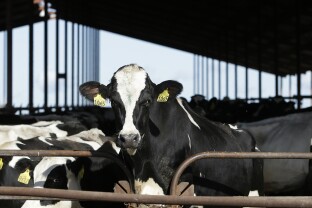Under pressure to control the emerging bird flu spreading through U.S. dairy cattle, the Biden Administration is trying to calm fears that its agencies are not working together.
The number of agencies involved in tracking the spread of bird flu — and their competing interests — can make collaboration complicated, political and slow. Lawmakers voiced concerns this week that divisions between agencies could hamper a successful response to the outbreak.
“We want to make sure that these departments that tend to operate in silos, and don’t talk to each other… We want to find out whether or not they are cooperating,” Sen. Chuck Grassley said to NOTUS Thursday. Grassley was among a bipartisan group of senators who sent a letter to the USDA on May 6 asking for a coordinated, interagency approach.
Friendship and teamwork were in the air during Friday’s press call with Agriculture Secretary Tom Vilsack and Health and Human Services Secretary Xavier Becerra, who praised their agencies’ relationship as they announced a range of initiatives to increase bird flu surveillance among U.S. dairy herds and workers.
“Big shoutout to the team at USDA,” Becerra said. “Secretary Vilsack and his folks have been working closely with us.”
Both secretaries repeatedly complimented the other agency’s collaboration and communication throughout the call.
The H5N1 virus has been devastating bird populations globally over the last several years. The virus likely spread from dead wild birds to cows in Texas, and a multistate outbreak was detected and announced by the Center for Disease Control on March 25. The virus has now infected cows in at least 42 herds in nine states, Vilsack said in the press call. Only two human cases have been detected and announced in the U.S. thus far, and the risk of human-to-human transmission remains low, according to the CDC.
Still, public health researchers and former USDA veterinarians told NOTUS that the federal and state agencies often struggle to successfully and quickly track animal viruses, and the agencies should be more prepared than they are now to reduce future pandemic risk.
Sign up for the latest from NOTUS.
The systems to track that spread in the U.S. are not robust across all animals, according to Ann Linder, a researcher at Harvard’s animal law and policy program who has interviewed farmers and officials about disease tracking.
“You have these divisions and siloing and competing priorities, which also exist at the state level between departments of ag and departments of health. And in the middle of all of that alphabet soup, you have farmers and producers who are wondering what to do and worrying about their own economic interests,” Linder said.
The USDA is responsible for monitoring diseases in livestock, but it must work with state agriculture agencies to test animals. The CDC monitors human transmission, but it too must partner with state agencies for testing. The Food and Drug Administration separately monitors food safety, including testing for diseases in animal products.
The agencies also have different priorities that sometimes are at odds with each other.
“The challenge between CDC and the USDA is that CDC will view the USDA as being not on the side of public health, but on the side of the industry and trying to protect the industry,” said Joseph Annelli, a former USDA official who was involved in coordinating interagency efforts to track animal diseases during his 30 year tenure. He said that collaboration between the agencies improved during his time there, and the CDC has a false impression of the USDA’s interests, but the political divisions remained when he left in 2018.
Another former USDA veterinarian, who asked to remain anonymous in order to protect his relationship with the agency, agreed, saying that collaboration on the staff level can be successful, but efforts are often complicated and slow when they move up the chain. Arguments over money and responsibility sometimes killed collaborative initiatives at the higher level, he said.
Two of the leading House and Senate Republicans — Sen. John Boozman and Rep. Glenn Thompson, chair of the House Agriculture Committee — argued in a letter to the Biden White House on April 26 that the USDA should be the “foremost authority” and take point in agency coordination.
Becerra and Vilsack announced initiatives Friday that would reimburse farmers and farmworkers for testing, personal protective equipment and lost milk productivity from sick cows. They also laid out investments in laboratory capacity and services, and said the agencies are encouraging states to increase surveillance and monitoring in areas federal officials cannot operate. The federal agencies cannot require farms or workers to participate in testing for the virus, but the USDA will require that any lactating cows moving across state lines test negative for the virus.
“Avian influenza in dairy cows is an excellent dress rehearsal for something worse, and I’m hoping it’s not itself worse later on. So if we get what we hope, which is control, then using this as an opportunity to start strengthening… surveillance systems is exactly what we should be doing,” said Meghan Davis, a Johns Hopkins University professor and former dairy veterinarian.
—
Anna Kramer is a reporter at NOTUS. Claire Heddles, a NOTUS reporter and an Allbritton Journalism Institute fellow, contributed to this report.
Sign in
Log into your free account with your email. Don’t have one?
Check your email for a one-time code.
We sent a 4-digit code to . Enter the pin to confirm your account.
New code will be available in 1:00
Let’s try this again.
We encountered an error with the passcode sent to . Please reenter your email.


